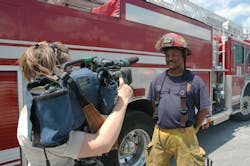PIO 101: The Basics of Media Relations for the Fire Service
It has been said that experience is the best teacher. It can also be the harshest. As a public information officer (PIO) for the Chattanooga Fire Department, I’ve worked hard to get the best training I can get to do my job. Yet, many of the things I’ve learned over the years did not come from a classroom or a book, but rather from the school of hard knocks.
If you’re new to the PIO business, the following information may be of some help to you. If you’re like me and have been around the block a few times, you might still benefit from a refresher on the basics. There are many ways to be an effective PIO. The information below summarizes what I’ve learned over the years and what’s worked for me.
Establishing a Rapport with the Media
Whether you’re a part-time or full-time PIO, it’s a good idea to get to know your local news media. If you’ve been interviewed by a network personality like the Today Show’s Matt Lauer, good for you, but you’re not going to be dealing with him on a regular basis. In general, you will be dealing with local reporters, photographers, assignment editors, producers and news directors. For the sake of brevity, I will from this point on refer to all of them as “reporters.”
To do your job effectively, it’s helpful to know reporters by name. This could involve personally visiting the newsrooms and introducing yourself, or hosting an informal get-together at your place. Introduce them to your fire chief and other chief officers and give them a short tour. The whole idea is to get acquainted, because the better you know each other on the front end, the better you can deal with them when it’s “show time.”
Working with the Media on Fire/Rescue Scenes
How you and your colleagues deal with reporters on fire/rescue scenes is critical. Your firefighters will most likely be busy. Your job is to keep reporters out of the way, and to facilitate their coverage. In Chattanooga, TN, we have a great working relationship with our police department, but occasionally the patrol officers will keep reporters a little too far away from the action. When that occurs, I will physically escort the reporters to a safe spot where they can see the firefighters at work. It does not help you or your department to hide your efforts. Your firefighters are the proverbial good guys. Show them off whenever you can.
Occasionally, you will have reporters get a little too close to the action. They’re just trying to get a good shot, but safety isn’t always their primary concern. In that event, it’s okay to be polite but firm in directing them back to a safe area. On a large fire scene, you cannot guard the entire site. Scene tape works wonders for giving the media visible guidelines for boundaries and in my experience, few reporters feel comfortable crossing it. Getting back to my earlier point, if you make the effort to give them a good vantage point, they are less likely to wander into an unsafe area. If the reporters are already in place before you arrive, try to go to them first or at least make eye contact with them so they know that you know they are there. This lets them know that they can expect to receive some information from you fairly soon.
Getting the Facts
Once the reporters are in a good, safe spot, you can leave them temporarily to get the information you’ll need. I get most of my information from the incident commander, but I’ll also get useful information from the first company to arrive on the scene, fire investigators and even the fire victims.
It’s worth noting here that getting the facts is a truly crucial part of the PIO’s job. Accuracy is paramount. It takes a long time to build up credibility as a truthful, reliable spokesperson for a fire department. However, one serious mistake can undo all that credibility in the blink of an eye. Check and double-check your facts — especially names — and use spell-check often.
Every PIO has his or her own style on how to present the facts to the media. Since I have a journalism background, I utilize part of what I’ve learned from that profession to help me as a PIO. For example, I use attribution. In my news releases, I tell the media where I got my facts. In a typical news release, I might include something like this: “Battalion Chief Joe Firefighter said the fire caused considerable damage to the house, with the dollar loss estimated at $100,000.”
This technique accomplishes a couple of things. First, you’re showing the public that there are many more people involved in the fire department than just you and the fire chief. To use a sports metaphor, you’re showing everyone that you’ve got a “deep bench” with lots of professionals who know what they’re doing. Secondly, most firefighters — though they won’t admit it — like to see their names in print. It may be old hat for seasoned officers, but most firefighters enjoy getting a little recognition for their efforts.
What Do Reporters Want to Know?
Really, it’s fairly simple. Depending on the nature of the incident, they want answers to six basic questions: Who? What? When? Where? Why? and How? Whose house is this? What happened? What time? What’s the address? And in the Why/How category, what started the fire? Get facts to answer those basic questions and you’re well on your way to facilitating media coverage and solidifying your rapport with reporters.
Depending on the incident, there may be other facts you will need to include. Were there any injuries or fatalities? Was there a working smoke alarm in the house? Did a neighbor try to go in and carry a victim out? If so, that’s something you need to include. You don’t want to say the same thing every time, so mix it up and use relevant facts. There’s no point in mentioning a missing smoke alarm if the house was empty.
When Do They Want to Know It?
The short answer to that question is, ASAP. As PIO, you operate on a different timeline from your co-workers and occasionally it can be a little demanding. If you’ve been on a big fire overnight, you can’t just leave the scene and go home to rest with the intention of sending out a release the next day. The news business does not operate that way. If you wait until the next day to send out a news release, then it’s not NEW, is it? The media probably knows about the fire and they will want to report on what happened in their morning newscasts. That’s where you come in. You need to remain on the job to provide as much information as you can. After you’ve done that, then you can take a break.
No, you don’t work for the media, but you should be aware of media deadlines and try to accommodate them when possible. Do this consistently and you will become a “go to” PIO for the media. How quickly you should respond to media requests depends on what they want. For incidents like fires, you should be able to offer up some facts within a few minutes or hours. Obviously, other facts, such as the cause of the fire, may take more time. It is perfectly acceptable to respond to a reporter’s question with “I don’t know.” The next words from a good PIO though, will be “I’ll find out and get back to you as soon as I can.”
Not every reporter request requires a quick response. If a reporter wants to do a story on code inspections for example and requests inspection reports for the past year, you can reasonably tell the reporter that gathering that kind of information will take more time, possibly several days or longer.
PIOs must be able to provide reliable information in a timely manner. If you’re not willing to work with that kind of mindset, then perhaps the PIO job is not for you. Being a PIO can be fun and rewarding, but like any other profession, it takes some training and effort to do it right.
Next Time: Tips for News Releases and Media Interviews
BRUCE GARNER is the public information director for the Chattanooga Fire Department, a Class 2 ISO fire department in southeast Tennessee. He has a B.A. in English from Lee College (now Lee University) and was a former radio/TV reporter before switching to the other side of the microphone. After serving 10 years as a PIO with Hamilton County Emergency Services, he accepted his current position with the Chattanooga Fire Department, where he has been for the past 11 years. Utilizing his experience with emergency management, he has also served as chairman of the Hamilton County Local Emergency Planning Committee for six years, and is a member of the National Information Officers Association and Public Relations Society of America. You can reach him by e-mail at [email protected].
About the Author

Bruce Garner
Firehouse.com Contributor
Bruce Garner is the Public Information Director for the Chattanooga Fire Department, a Class 2 ISO fire department in southeast Tennessee. Bruce has a B.A. in English from Lee College (now Lee University) and was a former radio/TV reporter before switching to the other side of the microphone. After serving 10 years as a PIO with Hamilton County Emergency Services, he accepted his current position with the Chattanooga Fire Department, where he has been for the past 11 years. Utilizing his experience with emergency management, he has also served as chairman of the Hamilton County Local Emergency Planning Committee (LEPC) for six years, and is a member of the National Information Officers Association (NIOA) and Public Relations Society of America (PRSA). You can reach Bruce by e-mail at [email protected].
